Environmental Engineering Reference
In-Depth Information
1.1
1.0
0.9
0.8
0.7
0.6
0.5
0
20
40 60
Plasticity index PI
80
100
120
FIGURE 3.57
Loading time-rate correction factor vs. plasticity index for undrained shear strength as measured by the field
vane. (From Bjerrum, L. et al.,
Proceedings of the 5th European Conference on Soil Mechanics and Foundation
Engineering,
Madrid, Vol. II, 1972, pp. 169-196. With permission.)
Apparatus:
The apparatus is similar to standard triaxial equipment except that the devi-
ator stress is applied cyclically. Sophisticated equipment allows variation in the frequency
of applied load as well as control of the waveform (sinusoidal or square, ramp or random).
In random loadings, actual earthquake histories are imposed.
Procedure:
The specimen is placed in the chamber and subjected to all-around confining
pressure. Backpressure may be applied to the pore water to saturate partially saturated
specimens and to simulate
in situ
pore pressures. Constant-amplitude cyclic axial load is
applied while specimen drainage is prevented, and pore-water pressure, axial load, and
axial deformations are recorded. For many soils, after a number of stress cycles, the pore
pressure increases to a value approximately equal to the cell pressure at which point the
soil will begin to deform excessively.
Limitations:
The test only approximately duplicates field stress conditions during earth-
quake loadings (USAEC, 1972).
Cyclic Simple Shear Test
Purpose:
The purpose is to measure strength parameters under intermediate to large strain
amplitudes and to measure the dynamic shear modulus
G
d
and the damping ratio of cohe-
sive and cohesionless soils.
Apparatus:
The simple shear device, described previously, in which the lateral load is
applied cyclically. Loading frequency and waveform are controlled.
Procedure:
The specimen is placed in the chamber and subjected to confining pressure.
Backpressure may be applied. A vertical stress is applied, and a cyclic shear force is
applied laterally while no drainage is permitted.
Comment:
The test most nearly duplicates field conditions for soils subject to strong
earthquake motion (large strains), although test boundary conditions will cause values to
be somewhat lower than reality (USAEC, 1972).



